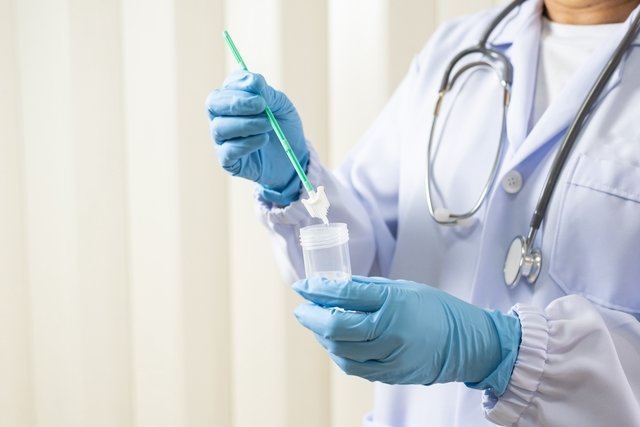Some tests to find out if you have HPV are the Pap smear, in women, and peniscopy, in men, in addition to clinical evaluation to observe the presence of genital, anal or oral warts, and molecular tests, such as hybrid capture or RT-PCR. . These tests may be recommended by the doctor to confirm the infection, lesion and/or type of HPV.
The human papilloma virus (HPV) is a virus transmitted through unprotected intimate contact, and may not have initial symptoms, being detected in routine examinations. However, it can also cause the appearance of warts in the genital, anal or mouth region, and increase the risk of cancer of the cervix, penis or mouth, neck or pharynx, for example. Know how to identify the symptoms of HPV.
The result of the HPV test must be interpreted by the doctor, being considered positive when the person has the virus, but does not necessarily present symptoms or increased risk of cancer, or negative, when the person is not infected with HPV. Furthermore, in positive cases, some tests are capable of identifying the type of HPV, allowing the doctor to indicate the most appropriate treatment.

Main tests to detect HPV
The main tests that detect and confirm HPV infection are:
1. Clinical assessment
The initial diagnosis of HPV is made by a gynecologist, in the case of women, or a urologist, in the case of men, through observation of the genital region, with the aim of identifying the presence of lesions or warts indicative of HPV infection.
Furthermore, in the case of HPV in the mouth, clinical evaluation is carried out by a stomatologist or dentist, by observing lesions on the lateral edge of the tongue, lips and roof of the mouth, for example, which may indicate an HPV infection. Know how to identify the symptoms of HPV in the mouth.
2. Papanicolaou
The Pap smear is a routine preventive exam for women that allows the detection of HPV and changes and diseases in the cervix, or other sexually transmitted infections.
This examination is carried out in the gynecologist's office, by scraping the cervix, using a spatula or brush, to collect cells from the cervix that are sent for analysis in the laboratory.
Despite being a fundamental test to assess a woman's health, the Pap smear is not sufficient to diagnose cervical cancer, for example, nor to determine the subtypes of the HPV virus. See how to prepare for the pap smear and understand the result.
3. Colposcopy
Colposcopy is a gynecological exam for HPV indicated when the gynecologist visualizes lesions on the cervix or vagina during clinical evaluation or when the Pap smear test showed any changes.
This examination is carried out by the gynecologist, in the office, using a colposcope, which is a type of microscope that looks like binoculars, which allows the doctor to identify lesions that are not visible to the naked eye, and observe the cells in the wall of the vagina, vulva and cervix in more detail. See how colposcopy is performed and how to prepare for the exam.
Colposcopy, as it is a more detailed examination, allows the gynecologist to detect precancerous lesions in the vagina and vulva or cervical cancer caused by HPV infection.
4. Penisoscopy
Penoscopy is an exam recommended for men, carried out by a urologist, to look for small lesions on the penis, scrotal sac or perianal region, or microscopic warts, which may be indicative of the presence of HPV. See how to identify HPV in men.
This examination is carried out in the urologist's office, using a peniscope, which is an instrument capable of enlarging and enlarging the image, after applying acetic acid, which allows the cells and their changes to be viewed in detail. Understand how penoscopy is performed.
Penoscopy is generally recommended by the urologist when the man's partner has tested positive for HPV or when she has genital warts, as well as in the case of a partner with penile or anal warts, for example.
5. Anuscopy
Anoscopy may be recommended by a gynecologist or urologist if a woman or man presents lesions in the anus possibly indicative of HPV infection.
This examination is carried out by the proctologist in the office, hospital or clinic, using an instrument called an anoscope, which has a camera and a lamp to analyze the mucosa of the anus in detail, evaluating possible lesions or cancer caused by HPV. See how anoscopy is performed.
6. Biopsy
The biopsy is normally done during the colposcopy exam, in women, or penisoscopy, in men, or anoscopy in men or women, when the doctor checks changes in the cells, caused by HPV, which may be indicative of cancer.
This examination is carried out by removing a small sample from the lesion to be sent to the laboratory and analyzed. Understand how a biopsy is performed.
Furthermore, in the case of HPV in the mouth, the stomatologist or dentist can also perform a biopsy to identify whether it really is HPV and what type, in order to recommend the most appropriate treatment.
7. HPV Serology
Serology tests are normally requested with the aim of identifying antibodies circulating in the body against the HPV virus, and the result may be indicative of active infection by the virus or simply a consequence of vaccination against HPV. Find out when the HPV vaccine is indicated.
Despite the low sensitivity of this test, serology for HPV is always recommended by doctors when investigating infection with this virus. According to the results of the exam, the need for further exams can be assessed.
8. Hybrid Capture
Hybrid capture is a more specific and widely used molecular test to identify the presence of 13 types of high-risk HPV and 5 types of low-risk HPV, but without identifying the exact type of virus, in addition to the viral load.
This test consists of taking small samples from the walls of the vagina and cervix, penis or anal or buccal region, which are sent to the laboratory to be analyzed with the aim of identifying the genetic material of the virus in the cell.
The hybrid capture exam is mainly performed when changes are verified in the Pap smear, colposcopy and/or anoscopy. See how the hybrid capture exam is performed.
9. RT-PCR
Real-time PCR (RT-PCR) is a highly sensitive and specific test, indicated to identify HPV infection of cells and tissues, even when the viral load is low or the person does not show symptoms of the infection, as it is done by identifying and analyzing the DNA of the virus.
In addition to identifying virus infection, RT-PCR allows you to accurately detect the type of virus and its quantity in the body.
The material used for this exam can be the same collected during the Pap smear or a biopsy fragment during colposcopy, penoscopy, anoscopy or oral evaluation, for example.
10. Hybridization on site
Hybridization on site is a test that allows you to detect the type of HPV and its location, as it is capable of identifying specific DNA or RNA sequences of the virus in tissues, and whether they are low risk or high risk.
This examination is carried out using biopsy material or cytological material from the Pap smear, allowing the doctor to associate the type of virus with the lesions found, the risk of developing complications, such as cervical, penile or anal cancer. , for example, and thus indicate the most appropriate treatment. Understand how HPV treatment is carried out.
11. Self-collection for HPV
Self-collection for HPV is a test that can be done at home by the woman using a cervical brush to collect material from the cervix and send it to the laboratory for analysis, allowing HPV infection to be identified.
However, this self-test is not yet available by the SUS, and it does not replace the medical Pap test and/or colposcopy, and must be carried out with a medical prescription, and the result must be interpreted by the gynecologist.



